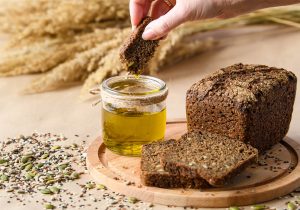
Defining and understanding whole grains
Whole grains have a whole lot going for them. They’re full of fiber, packed with nutrients, and help lower your risk for many diseases. And these good-for-you grains are great for adding delicious, nutty flavor and variety to your meals. However, if you only know of whole grains from labels on bread at the grocery store, it’s time to discover why these tiny grains are such a big deal for your health. So, what are whole grains and why are they more than just another half-baked food fad? Get a taste of what are whole grains and how they’re not the same as refined grains. Then, chew on the health benefits of whole grains and learn what are the 7 main grains, along with a field of whole-grain examples. Finally, get recommendations on adding whole grains to your diet so you know what you should eat and can go with the grain for good health.
The whole story on whole grains
All grains are not the same. Grains can be either whole or refined. What are whole grains? A whole grain consists of the entire grain, which is made of the bran, germ, and endosperm. The bran is the outer layer of the grain, and it’s full of B vitamins, minerals, antioxidants, and fiber. The innermost layer is the germ, which contains vitamins, healthy fats, and plant nutrients called phytochemicals. Between these layers is the endosperm, which is the starchy carbohydrate which contains vitamins and minerals. Whole grains contain all three of these elements. When grains are milled to create flour for food, they are sometimes stripped of the healthy bran and germ to make them last longer, yet this leaves them lower in vitamins, fiber, and minerals. These highly processed grains are known as refined grains and they’re used to make airy breads and sweets without the nutrition of whole grains.
The goodness of whole grains
There’s a whole lot to love about whole grains. They’re full of fiber, vitamins, minerals, and nutrients, but that’s just the beginning of their goodness. While fruits and vegetables may be bursting with disease-fighting antioxidants and phytochemicals, whole grains have even more! And study after study has shown that whole grains can help lower your risk of many diseases and health problems, while providing the energy you need to power through your day. Check out the health benefits of whole grains to see why these small grains pack such a big nutritional punch:
- Reduce your risk of cardiovascular disease, stroke, colorectal cancer, and type 2 diabetes.
- Lower your bad cholesterol levels.
- Raise your good cholesterol levels.
- Reduce your blood pressure.
- Keep you feeling full.
- Help control your weight.
- Increase your energy.
Get a taste of whole grains
There’s a whole world of whole-grain examples that go far beyond basic wheat. While some people may recognize what are the 7 main grains of wheat, corn, rice, barley, oats, rye, and sorghum, there are many more healthy grains that may be new to you. No matter the type you try or buy, there are countless ways to enjoy the health benefits of whole grains while adding hearty flavor and variety to meals and snacks. So, stock your pantry with the 7 main grains, along with a crop of other whole-grain examples, including:
- Whole wheat
- Oats
- Corn
- Rice
- Rye
- Barley
- Sorghum
- Quinoa
- Buckwheat
- Bulgur
- Amaranth
- Millet
- Kamut
- Farro
- Teff
- Spelt
A healthy look at the recommended daily intake
Whether you pile your plate with the 7 main grains or one of the lesser-known whole-grain examples, it’s important to get enough. According to the Dietary Guidelines for Americans, you should aim to eat 6 ounces of grain foods a day, with at least 3 ounces coming from 100% whole grains. Your SignatureMD-affiliated doctor can help you figure out the right amount for you. An easy way to tell if a food is made of whole grains is to look at the label on the back of the package. Foods that are 100% whole grain will have the words “whole” or “whole grain” as the first ingredient in the ingredients list. What should you eat? Mix up your menu from breakfast to bedtime with the following whole-grain tips:
- Build your breakfast around whole-grain cereals like shredded wheat, oatmeal, or whole-wheat bran flakes.
- Choose whole-grain toast and whole-wheat bagels over white bread and plain bagels.
- Swap whole-grain muffins for croissants and sweet rolls.
- Use whole-grain rolls and bread for sandwiches.
- Substitute whole-wheat tortillas and wraps for their white-flour counterparts.
- Make your salads healthier and heartier with whole grains like farro and buckwheat.
- Choose whole-grain pasta for salads, sides, and saucy meals.
- Select quinoa, barley, brown rice, or wild rice instead of plain white rice for soups, sides, and stir-fries.
- Use crushed whole-grain crackers, cereal, or oats in recipes instead of plain breadcrumbs.
- Bake batches of cookies, pancakes, waffles, and brownies with whole-wheat flour.
No matter how you slice it, serve it, toast it, or toss it, whole grains can do a whole lot of good for your health.
Sources:
- https://www.mayoclinic.org/healthy-lifestyle/nutrition-and-healthy-eating/in-depth/whole-grains/art-20047826
- https://wholegrainscouncil.org/whole-grains-101
- https://www.heart.org/en/healthy-living/healthy-eating/eat-smart/nutrition-basics/whole-grains-refined-grains-and-dietary-fiber
- https://www.hsph.harvard.edu/nutritionsource/what-should-you-eat/whole-grains/
About SignatureMD
SignatureMD is one of the nation’s largest firms providing initial conversion and ongoing support services to concierge medicine physicians. SignatureMD currently partners with over 200 affiliated primary care physicians and specialists across 35 states, and its network is rapidly expanding.